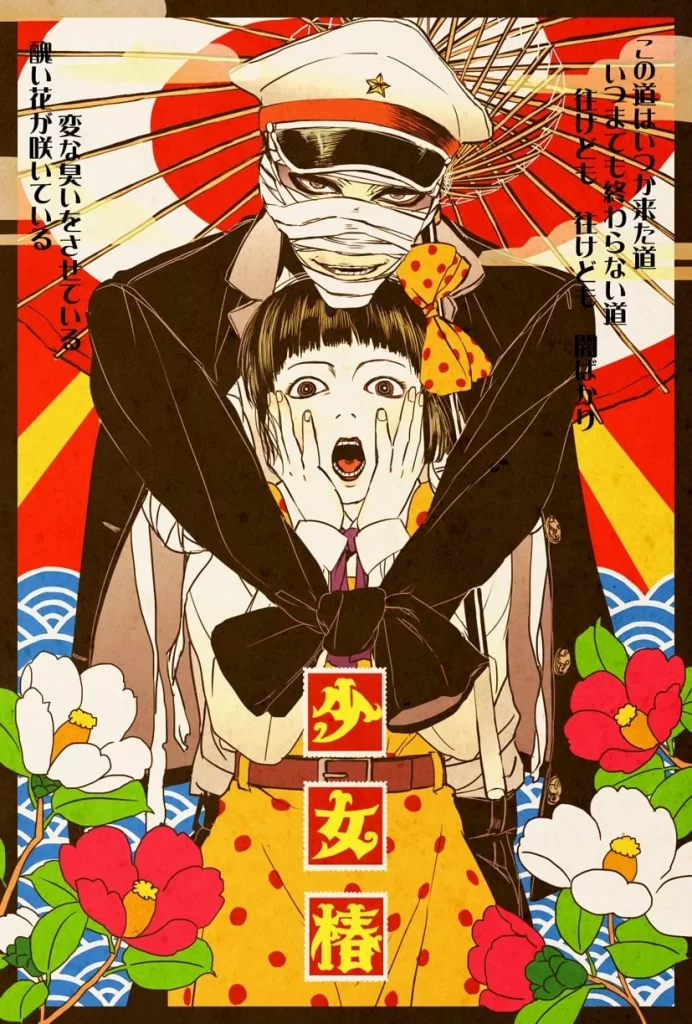Shōjo Tsubaki, often referred to as “The Camellia Girl,” is a story that has captured the dark and surreal corners of both Japanese and Western culture. This character, originating from the kamishibai (Japanese paper theater) tradition during the early Shōwa period, has become a symbol of the ero guro genre—an art movement blending eroticism and grotesque themes. The keyword “Midori Shoujo Tsubaki Anime” reflects the significant influence this story has had, particularly through its adaptations into manga, animated film, and live-action cinema. In this blog, we will explore the origins, adaptations, and cultural impact of Shōjo Tsubaki* analyzing its journey from a traditional tale to a controversial masterpiece.
Origins of Shōjo Tsubaki
The character Shōjo Tsubaki first emerged as a stock protagonist in the kamishibai performances that were popular during the early Shōwa period in Japan. These performances, which involved storytellers narrating tales accompanied by illustrated boards, often featured Shōjo Tsubaki as a young girl from a destitute family. She was forced to sell camellias on the streets before being sold into a revue show. This narrative, attributed to a creator named Seiun, became widely recognized, though its true origins remain uncertain due to the common practice of retelling and plagiarizing popular stories.
Shōjo Tsubaki represented the archetypal innocent yet tragic figure, embodying the hardships faced by many during the era. The story’s themes of poverty, exploitation, and innocence lost resonated deeply with audiences, cementing Shōjo Tsubaki as a significant figure in Japanese folklore.
Ero Guro Reinterpretation by Suehiro Maruo
The tale of Shōjo Tsubaki took on a new, darker life in the hands of Suehiro Maruo, a prominent figure in the ero guro movement. Maruo’s reinterpretation of the story, first published as a short story in an anthology and later expanded into a full-length graphic novel titled Mr. Arashi’s Amazing Freak Show, transformed Shōjo Tsubaki into a disturbing and visually striking narrative.
The graphic novel, published by Seirindō in September 1984, is a seminal work within the ero guro genre, which explores the intersection of eroticism and the grotesque. Maruo’s Shōjo Tsubaki delves into the dark underbelly of society, portraying the protagonist’s descent into a world of freak shows, abuse, and madness. The English edition of the graphic novel, now out of print, has become a highly sought-after collector’s item, reflecting its enduring impact on both Japanese and Western audiences.

Hiroshi Harada’s Semi-Animated Film: Midori
Hiroshi Harada’s semi-animated film Midori further solidified Shōjo Tsubaki’s place in the ero guro genre. Released in Tokyo on May 2, 1992, Midori is a faithful adaptation of Maruo’s graphic novel, capturing its disturbing imagery and unsettling atmosphere. Harada not only directed the film but also wrote the screenplay, produced it, and even contributed to its music. This level of personal involvement is reflected in the film’s unique style and its ability to evoke a sense of dread and discomfort.
Midori is notorious for its graphic content, which includes scenes of extreme violence and exploitation. The film’s controversial nature led to it being screened primarily at film festivals and through elaborate expanded cinema presentations. Despite—or perhaps because of—its disturbing content, *Midori* has achieved a cult status, particularly after its release on DVD-Video with English subtitles. This release allowed the film to reach a wider audience, further cementing its place in the ero guro canon.
Live-Action Film Adaptation: Midori: The Camellia Girl
In May 2016, the Shōjo Tsubaki story was once again brought to life, this time as a live-action film titled *Midori: The Camellia Girl, directed by Torico. This adaptation offered a new perspective on the classic tale, blending the visual elements of ero guro with the raw emotions of live-action performance.
The 90-minute film, produced by Link Rights and featuring music by Hitomi Kuroishi, was met with mixed reactions. Some praised its faithful adaptation of the source material, while others criticized its inability to fully capture the graphic novel’s intense and surreal atmosphere. Nevertheless, the live-action adaptation provided a fresh take on the Shōjo Tsubaki narrative, appealing to both longtime fans and new audiences.
Cultural Impact and Controversy
Shōjo Tsubaki has left an indelible mark on both Japanese and Western pop culture. The character’s journey from a traditional kamishibai protagonist to an icon of the ero guro genre highlights the story’s adaptability and enduring relevance. However, with its rise to prominence came controversy, particularly surrounding the explicit content of Maruo’s graphic novel and Harada’s animated film. The ero guro genre itself is a point of contention, often criticized for its depiction of taboo subjects.
Despite—or perhaps because of—its controversial nature, Shōjo Tsubaki continues to be a topic of discussion among anime and manga enthusiasts. Its various adaptations, from graphic novel to film, have each contributed to the story’s legacy, ensuring that Shōjo Tsubaki remains a significant, if polarizing, work within the world of Japanese media.
Conclusion
The story of Shōjo Tsubaki is one that transcends time and medium, from its origins in early Shōwa period Japan to its various adaptations in the modern era. The keyword “Midori Shoujo Tsubaki Anime” encapsulates this journey, reflecting the story’s impact on both Japanese and Western audiences. Whether through Suehiro Maruo’s graphic novel, Hiroshi Harada’s animated film, or Torico’s live-action adaptation, Shōjo Tsubaki continues to challenge and provoke, solidifying its place in the annals of ero guro history.
For those intrigued by the darker aspects of anime and manga, Shōjo Tsubaki offers a glimpse into a world where innocence and horror collide. Its various adaptations provide unique perspectives on the story, each contributing to the rich tapestry of Shōjo Tsubaki’s legacy.

Akane, known as akanecco._ on Instagram, is a passionate and experienced Anime creator specializing in anime content. With 317 engaging posts and a dedicated following of 12.7K, Akane has become a trusted authority in the anime community. Through detailed reviews, character explorations, and insightful analyses, Akane shares an extensive knowledge of anime, captivating and educating fans with every video. Follow Akane on Instagram to immerse yourself in the vibrant world of anime and join a community of like-minded enthusiasts here- Facebook and Pinterest.





